One of the biggest low carb lifestyle challenges for many people is limiting our intake of baked goods, sweet and savory, which are famously high in carbohydrates. That’s why we’ve created this guide for low carb baking—so you can have your cake and eat it too! With the right flours and binders, plus a little experimentation and practice, you can learn how to bake low carb baked goods that will satisfy your cravings and keep you on track to your goals.
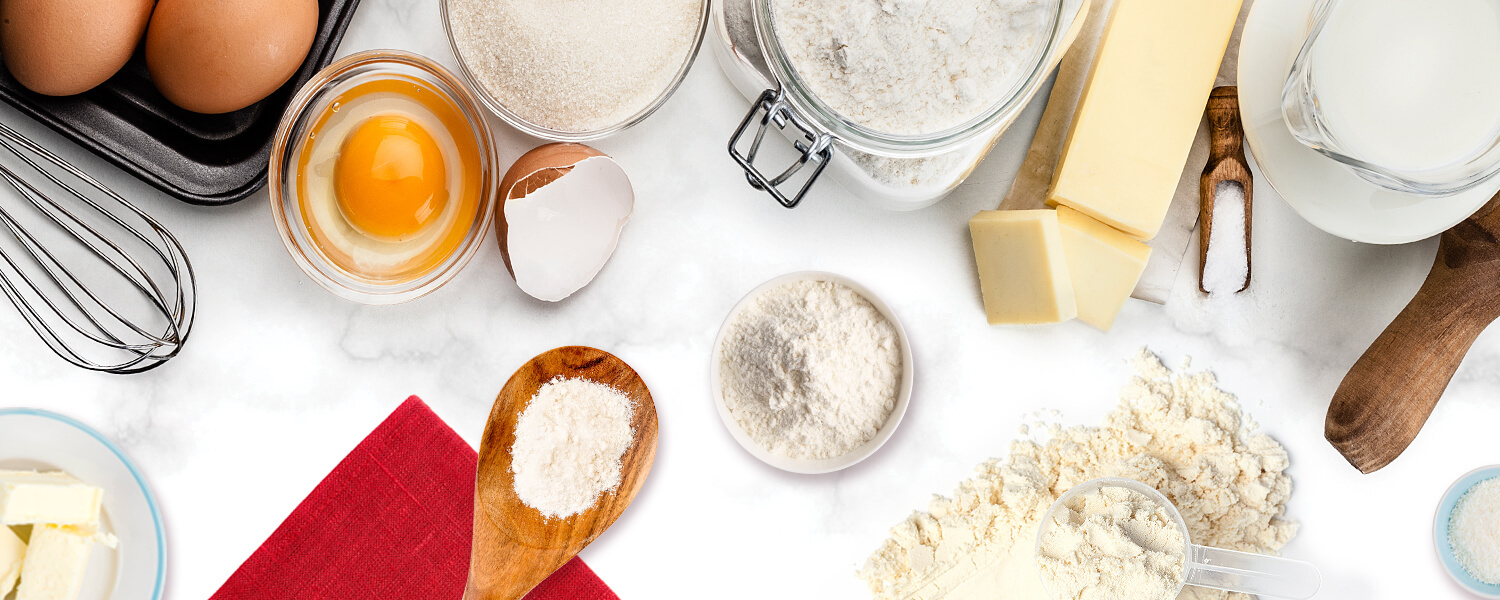
Our low carb baking highlights are below but you can also download a comprehensive guide to reference any time you need it!
Low Carb Flour Alternatives
These flours are used to replace all-purpose white flour (from wheat) which is too high in carbohydrates (23 net carbs per ¼ cup) to be used in keto or low carb baking.
Blanched Almond Flour, super-fine grind
5.75 net carbs per ¼ cup | Ease of use: Easy
Made up of finely ground blanched almonds without the skins, this flour is one of the most widely available and lower cost low carb baking ingredients—and one of the easiest to use. As a 1:1 replacement for AP flour, you can use all the same measurements as written in your favorite recipes.
Try it in this recipe: “Sugar” Cookies
Almond Meal, from whole almonds
4 net carbs per ¼ cup | Ease of use: Easy
Though they are made of similar ingredients, almond meal is very different from almond flour. Almond meal is a more coarse grind of whole almonds, skins and all.
Those included skins means almond meal is high in fiber, which means it has lower net carbs, but the coarser grind means it’s a little heartier and denser when used as a 1:1 replacement for AP flour in baked goods. (Which means it’s perfect for things like muffins and quick breads!)
Try it in this recipe: Almond Muffin in a Minute
Soy Flour
5.4 net carbs per ¼ cup | Ease of use: Easy
Soy flour is a very fine-textured flour made from raw soybeans that, like almond flour, can be used as a 1:1 replacement for AP flour. In addition to being a low carb baking ingredient, it’s also high in protein. That high protein content helps hold your baked goods together, requiring less added binder. It does add a slight soy flavor to any recipe and, while it is gluten-free, soy flour is not recommended for those allergic to soy.
Try it in this recipe: Atkins Coconut Layer Cake
Flaxseed Meal
0.5 net carbs per ¼ cup | Ease of use: Moderate
This high fiber flour is made of coarsely ground flaxseeds, and one of the low carb baking ingredients with the fewest net carbs. Its high fiber content means that it isn’t a 1:1 AP flour replacement, so be careful with your measurements. When mixed with water, flaxseed meal can replace eggs for allergy-sensitive or vegan baking, and can help bind gluten-free baking recipes. Be sure to use your flaxseed meal quickly; it contains oils that could go rancid over time.
Try it in this recipe: Muffin in a Minute
Coconut Flour
7 net carbs per ¼ cup | Ease of use: Hard
Coconut flour, made from finely ground dried coconut meat as a natural byproduct of coconut milk production, has a higher learning curve than some other low carb baking ingredients. Because of its high fiber content, it can require up to 4 times the amount of eggs to properly hydrate the flour. It also imparts a slight coconut flavor, which can enhance recipes with tropical or coconut flavors in them.
Try it in this recipe: Low Carb Coconut Bread
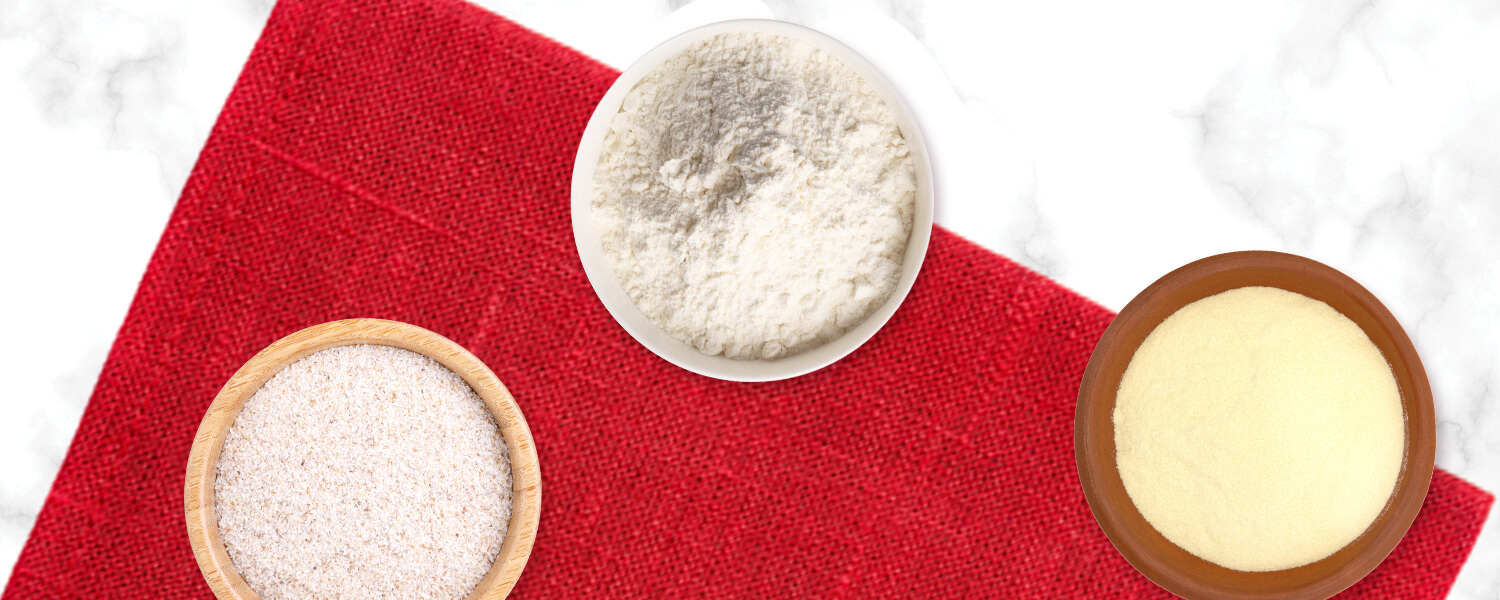
Low Carb Binders
Nearly all low carb flour alternatives require some sort of binder in order to hold the finished baked goods together, sometimes in addition to traditional binders like eggs, otherwise they may fall apart.
Wheat Gluten or Vital Wheat Gluten
6 net carbs per ¼ cup | Ease of use: Moderate
Wheat gluten can replace 7-15% of flour in most recipes, and helps add structure, fluffiness, and a better rise to baked goods by adding gluten. Using this binder will make the finished product not gluten free, even if you’re using gluten free flour.
Try it in this recipe: Atkins Low Carb Wheat Bread
Whey Protein Concentrate, unflavored
1.5 net carbs per ¼ cup (depending on the brand) | Ease of Use: Moderate
Not just for smoothies, this binder can also add texture (and protein, of course!) to your favorite baked goods. Whey protein concentrate can replace up to one-third of the required flour in most recipes, but be careful not to use too much, or your baked good may end up with a chewy, rubbery texture.
Try it in this recipe: Keto Banana Bread
Xanthan Gum, Psyllium Husk Powder, or Glucomannan
0 net carbs per ¼ cup | Ease of Use: Hard
To hold baked goods together, these binders replace wheat gluten in gluten free, low carb baking and, when used in small amounts, can also replace eggs. These may be harder to find than other binders, and may take a little additional trial and error to find the right amount to use in each recipe.
Try it in this recipe: Blueberry Scones with Lemon Glaze
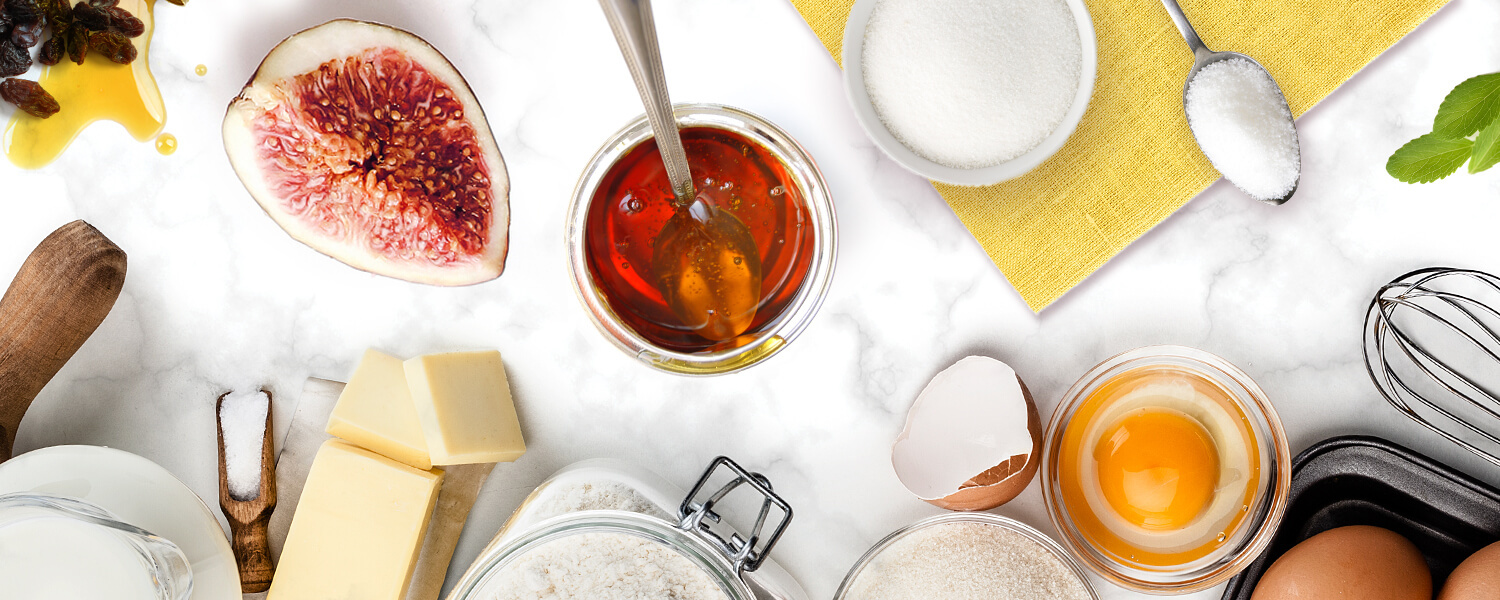
Low Carb Sweeteners
While there are many options for sugar-free sweetener alternatives, they have considerable differences between them. The greatest differences you’ll find are in aftertastes and sweetness level. Some sweeteners are high impact—meaning that they are considerably sweeter than sugar—and you may only need to use a small quantity. Other sweeteners replace both the sweetness and bulk of sugar, and can
be used similarly to granulated sugar in recipes. Just like with sweeteners and binders, keto and low carb baking recipes frequently combine sweeteners to help minimize aftertaste and achieve a desirable level of sweetness.
Sugar Free Maple Syrup
1 net carb per ¼ cup | Ease of Use: Easy
While not a 1:1 replacement for granulated sugar, sugar free maple syrup is an easy 1:1 swap for maple syrup on pancakes, waffles, and in baked goods. As a liquid sweetener, it dissolves easily and can be used in cold beverages.
Try it in this recipe: Keto Pumpkin Spice Chaffle
Sucralose Based Sweetener, such as Splenda
10.9 net carbs per ¼ cup | Ease of Use: Easy
Sucralose based sweeteners are an easily-found artificial sweetener group that works as a 1:1 replacement for granulated sugar. As found more widely, this sweetener group is usually mixed with maltodextrin, another artificial sweetener, it isn’t zero net carb and can leave an aftertaste. (Pure sucralose, which is 600 times as sweet as granulated sugar, is also available in bulk at some online retailers, but it’s difficult to both find and use.)
Try it in this recipe: Holiday Cookies
Allulose
0 net carbs per ¼ cup | Ease of Use: Moderate
Allulose is a very low calorie sweetener found naturally in fruits like figs and raisins with no aftertaste. As it is derived from fruits, it is 70% as sweet as sugar and is not a 1:1 replacement to granulated sugar. However, like granulated sugar, allulose can caramelize and brown and works beautifully in softer, lighter textured recipes like cakes and muffins. Since it’s a bit of a newer sugar alternative, it might be harder to find in some grocery stores.
Xylitol
0 net carbs per ¼ cup | Ease of Use: Moderate
A natural occurring sugar alcohol, xylitol is 95% as sweet as granulated sugar but can be used as a 1:1 sugar replacement. It has a significant cooling mouthfeel and aftertaste, and take care not to eat more than 2 tbsp per serving as it may cause some gastric effects. Additionally, be sure to keep xylitol and foods containing it away from furry friends, as it is toxic to pets.
Try it in this recipe: Double Chocolate Cookies
Erythritol, such as Swerve
0 net carbs per ¼ cup | Ease of Use: Moderate
This naturally occurring sugar alcohol is widely available in granulated, confectioners’ (powdered), and brown forms, making it a versatile addition to your low carb baking pantry. Erythritol is not a 1:1 replacement for granulated sugar, and is 70% as sweet. It has a cooling mouthfeel and aftertaste that can pair well with cold or frozen desserts, but it doesn’t dissolve as easily as sugar into liquids. Take care not to eat more than 2 tbsp per serving as it may cause some gastric effects
Try it in these recipes: Pumpkin Spice Cheesecake, Soft Ginger Cookies
Erythritol-Stevia Blend, such as Truvia or Wholesome Organic Stevia
0 net carbs per ¼ cup | Ease of Use: Moderate
A blend of sugar alcohols and plant based sweeteners, this off-the-shelf combination helps increase sweetness and counteracts aftertaste. It is not a 1:1 sugar replacement. Depending on the brand, this blend may be sweeter than sugar, so be sure to check the packaging for sugar equivalents.
Try it in these recipes: Low Carb Chocolate Chip Cookie Dough Bread
Stevia Extract Powder
0 net carbs per ¼ cup | Ease of Use: Difficult
A plant based sweetener that is 200-300 times sweeter than granulated sugar, stevia extract powder is best used as a sweetness enhancer to an existing sweetener rather than an outright sugar replacement. It is a very concentrated sweetener with a licorice flavor that can leave an aftertaste, and is not a suitable 1:1 replacement for sugar.
Try it in this recipe: Pumpkin Cake Roll
Monk fruit Extract or Luo Han Guo
0 net carbs per ¼ cup | Ease of Use: Difficult
Monk fruit extract is a plant based extract derived from the monk fruit, a native fruit found in southern China and northern Thailand, that is 150-200 times sweeter than sugar. Its extreme concentration can mean it sometimes leaves an aftertaste, and is not a 1:1 sugar replacement. Some brands also mix monk fruit extract with erythritol to decrease aftertaste.
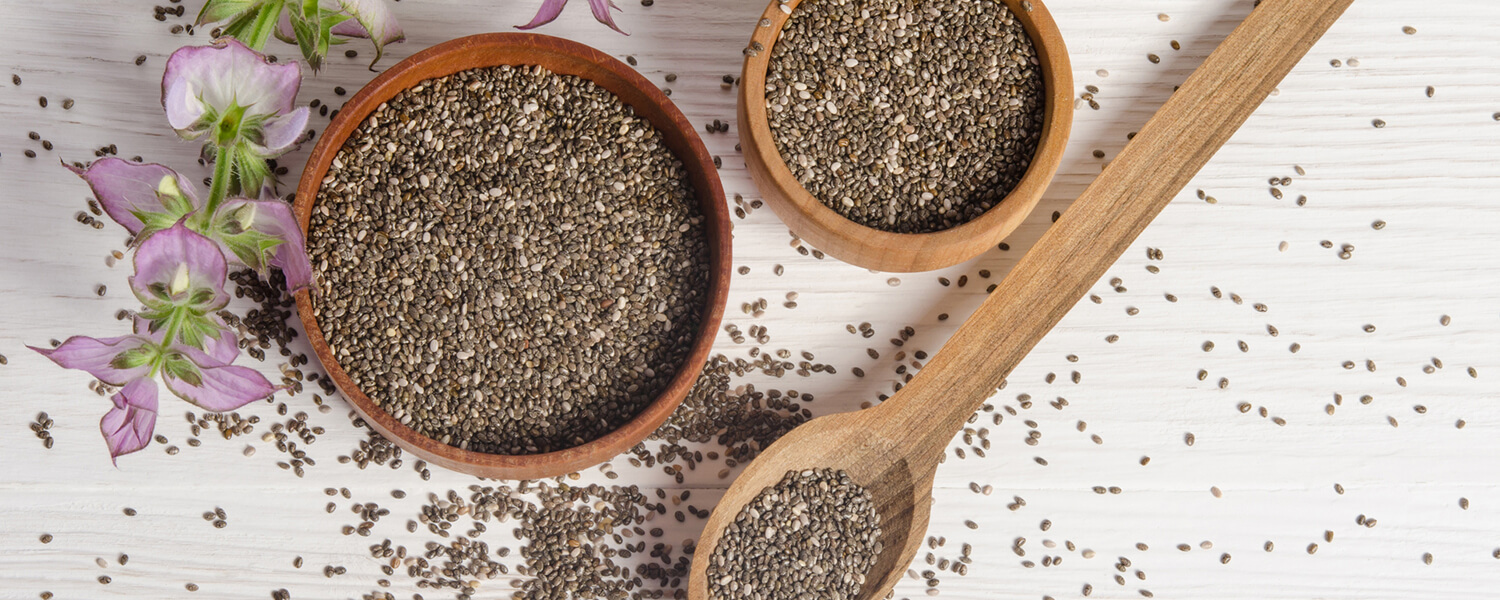
Low Carb Baking Add-Ins
These low carb baking ingredients are frequently used as alternatives to classic sugar sweetened ingredients and/or to help reduce net carbs in a recipe.
Unsweetened Almond or Coconut Milk Beverage
0-0.5 net carbs per ¼ cup, depending on the variety and brand
Though lower in protein and fat than whole cow’s milk, use these milk alternatives as a 1:1 replacement for cow’s milk to reduce carbs in a recipe or make a recipe vegan.
Try it in this recipe: Dark Mocha Pudding
Sugar Free Chocolate Chips
12-32 net carbs per ¼ cup, depending on the brand
While lower in net carbs than conventional chocolate chips, sugar free chocolate chips can still be a significant contributor of net carbs to any low carb baking recipe, so be sure to use them in moderation.
Try them in this recipe: Pinwheel Cookies
Hemp Hearts or Hulled Hemp Seeds
1.9 net carbs per ¼ cup
Hulled hemp seeds, also known as hemp hearts, are a lower carb replacement for oats, nuts, or other chewy components of baked goods. They are very high in fiber and a source of omega-3 fats.
Try them in this recipe: Low Carb Oatmeal Chocolate Chip Cookies
Chia Seeds
2.5 net carbs per ¼ cup
Chia seeds are very high in fiber and a source of omega-3 fats. They form a unique, gel like texture when soaked in liquids like water or milk. Use them to make no cook puddings, or as a replacement for eggs in vegan baking.
Try them in this recipe: Chocolate Chia and Coconut Pudding
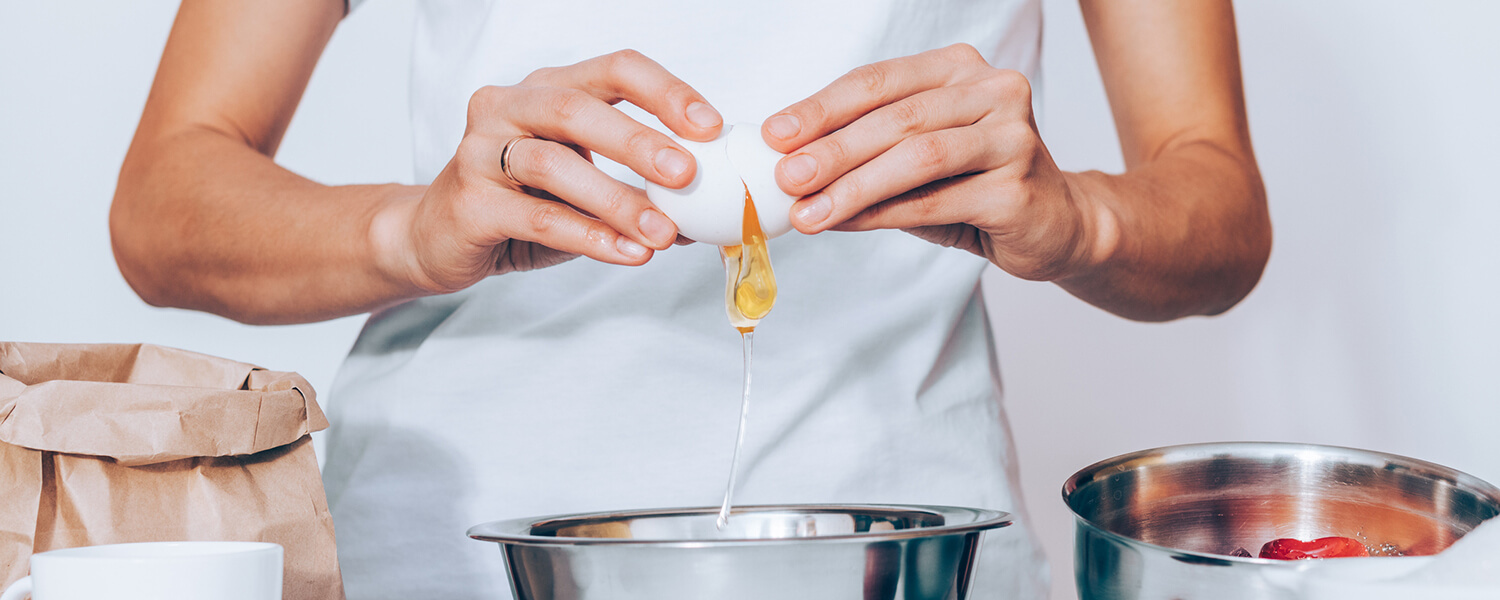
Low Carb Baking Tips
Sometimes, adapting a favorite, high carb recipe into something lower carb can take practice, as low carb baking ingredients perform differently than wheat flour. Keep these tips in mind as you experiment, and don’t forget: there are hundreds of tried-and-true Atkins recipes of old staples and new favorites that might come close to what you’re craving.
- Get experimental. Many recipes, including some of our own, use a combination of several low carb flours, binders, and sweeteners to get a comparative texture and sweetness to their high carb counterparts. Try taking inspiration from an existing low carb baking recipe to get an idea of what combinations work best.
- An extra egg or half an egg can be helpful to provide more structure for baking quick breads and muffins; additionally increasing the raising agent slightly can be helpful.
- Allow the baked item to sit and cool completely. Otherwise, you may end up with crumbs. Crackers and pie/tart crusts will be crisper and muffins and cakes will have a better texture and hold together if allowed to cool for a couple of hours.
- Bake at 25°F lower than you normally would for a longer time. Watch your oven carefully and cover with aluminum foil if it starts to brown too quickly.
Learning how to bake low carb can be a challenge, but it’s worth the reward when you can satisfy your cravings without going off track. Be sure to check out our Atkins recipes to try your hand at low carb baking, and don’t forget to share how your low carb baking journey is going in our Atkins community!
